Abstract
In this work, a flame retardant curing agent (DOPO-MAC) composed of 9,10-dihydro-9-oxa-10-phosphaphenanthrene-10-oxide DOPO and methyl acrylamide (MAC) was synthesized successfully, and the structure of the compound was characterized by FT-IR and 1H-NMR. The non-isothermal kinetics of the epoxy resin/DOPO-MAC system with 1% phosphorus was studied by non-isothermal DSC method. The activation energy of the reaction (Ea), about 46 kJ/mol, was calculated by Kissinger and Ozawa method, indicating that the curing reaction was easy to carry out. The flame retardancy of the epoxy resin system was analyzed by vertical combustion test (UL94) and limiting oxygen index (LOI) test. The results showed that epoxy resin (EP) with 1% phosphorus successfully passed a UL-94 V-0 rating, and the LOI value increased along with the increasing of phosphorus content. It confirmed that DOPO-MAC possessed excellent flame retardance and higher curing reactivity. Moreover, the thermal stability of EP materials was also investigated by TGA. With the DOPO-MAC added, the residual mass of EP materials increased remarkably although the initial decomposition temperature decreased slightly.
1. Introduction
Epoxy resin (EP), phenolic resin and polyester resin are three thermosetting materials. Because of their excellent physical and mechanical properties, chemical resistance, electrical insulation, processing properties and good adhesion properties, they are widely used in coatings, adhesives, electronic and electrical components and other fields [1,2,3]. However, the flammability of EP limits its further application. Thus, it is necessary to impart EP with good flame retardance [4,5,6].
Flame retardance of EP can be improved by introducing flame retardant, including additive type and reactive type ones [7,8,9]. The additive flame retardant has the advantages of a simple adding method, convenient operation and easy industrialization [10,11,12]. However, due to the absence of interaction between the additive and the resin, the flame retardant is easy to permeate and migrate, which can deteriorate the mechanical properties and flame retardance of materials [13]. By contrast with additive type one, reactive type flame retardant can avoid damage to the mechanical property of EP and solve emigration of additive type ones from the matrix through chemical connection between flame retardants and epoxy resin [14,15,16]. The reactive flame-retardant method includes reactive flame-retardant EP monomer and reactive flame-retardant curing agent. Among halogen-free flame retardants, phosphorus-containing flame retardants are popular products thanks to high efficiency. The P-containing flame-retardant monomer contains cyclotriphosphazene-, phosphaphenanthrene-, phosphonate-and phosphate-based EP monomers. However, flame-retardant EP monomer is usually used with unmodified epoxy resin due to the lower epoxy value and the poor mechanical properties of cured epoxy resin.
Compared with flame-retardant EP monomer, flame retardant curing agents are easily prepared and flexibility, and these have become a hot research area [17,18]. Recently, some flame retardant curing agent, such as P-modified Schiff-base, anhydride, aliphatic amine and imidazole, have been prepared to flame retard EP resins. For instance, Huo et al. [19] synthesized a DOPO-modified Schiff base curing agent (PBI) from 9,10-dihydro-9-oxa-10-phosphaphenanthrene-10-oxide (DOPO), 2-aminobenzothiazole and 1H-Imidazole-4-carbaldehyde for EP. The EP modified with PBI showed good flame retardance (UL-94 V-0; LOI ≥ 36%) and heat resistance. Liang et al. [20] developed a P-containing anhydride curing agent (BPAODOPE) for EP, and the EP/BPAODOPE system passed a V-0 rating when the phosphorus content reached to 1.75 wt%. Zhao et al. [21] prepared a phosphaphenanthrene/triazine-containing anhydride curing agent (TDA) that showed higher flame retardance than BPAODOPE at the same phosphorus content, which was attributed to the synergism of triazine and phosphaphenanthrene.
In addition, aliphatic amine and imidazole-based flame retardant curing agents also have been widely studied. For example, Shao et al. [22] synthesized a functional aliphatic amine curing agent (named DPPEI) from diphenyl phosphorus oxide and polyethyleneimine for EP. When the content of DPPEI was 35%, the EP/DPPEI passed a UL-94 V-0 rating and had a LOI value of 29.8% as well as a significant reduction in total heat release and smoke release. Xu et al. [23] prepared an imidazole-based flame retardant curing agent (named IDOP) from imidazole that showed excellent flame retardance due to free radical trapping effect in gaseous phase. Xie et al. [24] synthesized a furfural-based flame retardant containing DOPO (MBF-DOPO). The LOI of the epoxy composite reached 32.9% (with the V-0 rating in UL-94 test). The results showed that MBF-DOPO promoted the carbonization of the epoxy matrix and effectively isolated the gas and heat transfer during the combustion process, thus improving the fire resistance of the epoxy thermosetting resin.
The purpose of this work is to design and prepare an efficient P-N co-effect flame retardant for EP, greatly reducing the shortcomings and expanding the application range of EP. Because DOPO is a very efficient flame retardant structure and aliphatic amine has high curing activity, the combination of the two units will prepare a flame retardant curing agent with high activity and flame retardant efficiency. In this paper, a DOPO-based flame retardant curing agent, named DOPO-MAC, was synthesized from DOPO and MAC by the addition reaction. Its structure was confirmed by FTIR and NMR. In addition, the curing behavior of DOPO-MAC was investigated by non-isothermal kinetics. Finally, the thermal stability and flame retardance of EP was analyzed.
2. Experimental Procedure
2.1. Materials
DOPO (purity > 98%) was purchased by Shandong Mingshan chemical company (Linyi, China); Methyl acrylamide (MAC) (98%) and N,N-Dimethylacetamide (DMF) (99.9%) were bought by Aladdin (Shanghai, China); Epoxy resin (E-51, the epoxy value of 0.51 mol/100 g) was provided by Wuxi resin factory (Wuxi, China).
2.2. Synthesis of DOPO-MAC
A total of 0.01 mol DOPO, 0.01 mol methyl acrylamide and 10 mL DMF (as the solvent) were firstly added into a three-necked flask with a thermometer, reflux device and magnetic stirring device, and kept stirring until completely dissolved. Afterwards, the mixtures continued to stir at 140 °C for 4–8 h under N2. At the end of the reaction, the final product was obtained through filtration, washed with water and dried at in a vacuum drying cabinet at 60 °C for 10 h. The synthetic route is shown in Figure 1.

Figure 1.
Synthetic route of DOPO-MAC.
2.3. Synthesis of Cured DOPO-MAC/EP Composites
Different proportions of epoxy resin and as-obtained DOPO-MAC were blended at 90 °C for 1 h. Accordingly, the mixtures were poured into the mold, and cured at 100 °C for 1.5 h, 115 °C for 5 h and 135 °C for 2 h. The pure EP materials were prepared at room temperature with MAC as the curing agent. The formula of EP materials with different contents of flame retardant was shown in Table 1.

Table 1.
The formula of EP materials.
2.4. Characterization
Fourier Transform Infrared Spectroscopy (FTIR): Fourier Transform Infrared spectrometer L1600301 manufactured by PerkinElmer was used in the test. The synthetic product was a powder solid, so it was appropriate to use the KBr pressure plate method. A small amount of sample was mixed with KBr to be lapping, repressed and tested. The operation parameters were set to 4 cm−1, each sample was scanned 4 times, and the scanning range was 4000–400 cm−1.
Nuclear Magnetic Resonance Spectroscopy (1H-NMR): An Avance 600 NMR spectrometer manufactured by Bruker (Switzerland) was used. Dimethyl sulfoxide (DMSO) was used as the solvent, while tetramethylsilane (TMS) was used as an internal standard.
DSC Test: A DSC200F3 differential scanning calorimeter manufactured by Netcom Scientific Instruments (Shanghai, China) Co., Ltd. was used in the non-isothermal DSC test. A few samples were put into the furnace in a high-purity N2 atmosphere, and the flow rate was kept at 20 mL/min. Al2O3 was the reference material, and the heating rates were set at 5 °C/min, 10 °C/min, 15 °C/min and 20 °C/min, respectively. The test temperature ranged from room temperature to 250 °C, and the sample dosage was about 8 mg.
TGA was recorded by Netzsch 2209F1 thermo-gravimetric analyzer (Germany) under nitrogen atmosphere from 30 °C to 700 °C. Samples of about 15 mg were used in each measurement and were placed in an open oven at a heating rate of 10 °C/min.
LOI test was conducted on a TTech-GBT2406-2 oxygen index meter in view of GB/T 2406 and UL 94 test was carried out by a TTech-GBT2408 vertical burning test on the basis of GB/T 2408. The relevant spline sizes were 130× 6.5 × 3.2 mm3 (LOI test) and 130 × 13 × 3.2 m3 (UL 94). The samples were held 10 cm over the burner and rapidly removed after exposure to outer flame for 10 s (V-1: The flame is extinguished within 30 s after two 10 s combustion tests. It cannot ignite the cotton under 30 cm. V-0: The flame is extinguished at 10 s after two 10 s combustion tests).
Tensile and flexural experiments were performed on a CMT4104 universal testing machine at a speed of 2 mm/min according to GB/T 1040.2-2006 and GB/T 9341-2008, respectively. ZBC1251 pendulum impact testing machine was adopted to study Charpy impact strength of materials according to GB/T 1843-2008. Additionally, the dumbbell-shaped specimens with thickness of 2 mm were applied in tensile tests, and the rectangular specimens with the size of 80 × 10 × 4 mm3 were adopted in three-point bending tests. The result was the average of five measurements.
3. Results and Discussion
3.1. FT-IR and 1H-NMR Characterization of DOPO-MAC
The infrared spectra of the vacuum-drying product were measured by FT-IR spectrometer. The infrared spectra were as showed in Figure 2. As seen in Figure 2, some typical characteristic peaks such as P-H (2438 and 2386 cm−1), P = O (1204 cm−1) and P-O (914 cm−1) appeared in DOPO spectra [25]. For DOPO-MAC, P = O and P-O peaks still existed, while the P-H stretching vibration peak disappeared, which indicated the reaction between DOPO and MAC [26]. The absorbance peaks at 3439 and 1664 cm−1 were N-H and C = O stretching vibration, respectively.
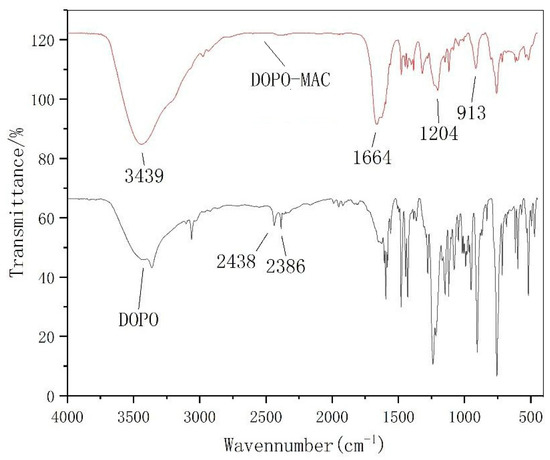
Figure 2.
FT-IR of DOPO and DOPO-MAC.
The structure of the resultant product was further investigated by 1H-NMR spectra, as shown in Figure 3. The peak at 7.21 ppm was attributed to N-H bond; the peaks at 1.2 and about 2.5–3 ppm belonged to hydrogen protons of alkanes; the peaks at 7.21–8 ppm were ascribed to the benzene ring structure [27]. The peak area was consistent with the number of corresponding hydrogen atoms.
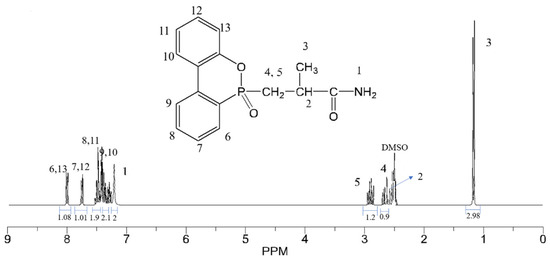
Figure 3.
1H-NMR of DOPO-MAC.
3.2. Kinetic Study on DOPO-MAC/Epoxy Resin System
There are three hypothesis that should be followed when it comes to kinetic investigations [15]:
(1) The total area of the exothermic curve is directly proportional to the total heat released during the curing reaction.
where ΔH represents the heat release of the whole curing reaction, dH/dt is the heat flow rate, dα/dt is the curing reaction rate.
(2) The reaction rate during curing is directly proportional to the heat flux at that time.
where α indicates the degree of curing reaction; f(α) is a function of α, and the specific form is determined by the curing mechanism; and k(T) is the reaction rate constant, which is determined by Arrhenius equation:
where A is the former factor, E the activation energy, R is gas constant and T is the temperature.
dα/dt = k(T)f(α)
Based on the above assumptions, many model methods can be used to calculate the kinetic parameters of epoxy resin curing reaction, including the equations of Kissinger, Flynn-Wall-Ozawa and Crane.
3.2.1. Curing Reaction Heat
Epoxy resin system containing 1.0% of phosphorus was investigated by non-isothermal DSC tests with the heating rate of 5 °C/min, 10 °C/min, 15 °C/min and 20 °C/min. As shown in Figure 4, the initial curing temperature (Ti), peak curing temperature (Tp) and termination curing temperature (Tt) of a non-isothermal DSC curve change due to changes in the heating rate. As shown in Figure 4, the curve of the curing reaction was smooth and there was only one significant exothermic peak. The graph showed the trend of the characteristic temperature during the curing process changing with the heating rate. It can be seen that the onset temperature, peak temperature and termination temperature of the curing reaction gradually increase as the heating rate (β) increases.
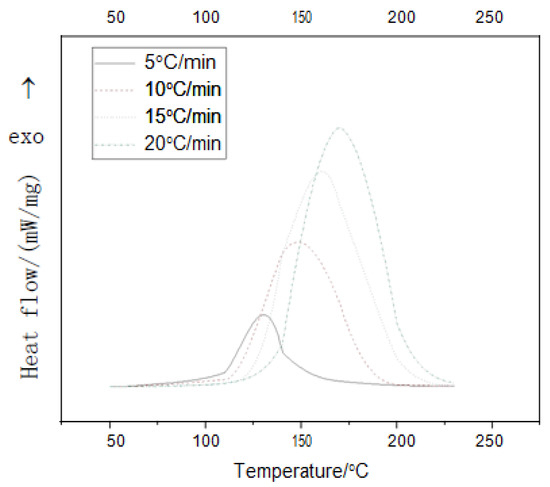
Figure 4.
DSC curves of epoxy resin curing system at different heating rates.
According to Table 2, a linear relationship between characteristic temperature and heating rate can be plotted, as shown in Figure 5. By plotting the Ti, Tp and Tt with the heating rate β, and using an extrapolation method to make β = 0, the optimal curing temperature for static cure is obtained, which was Ti of 101 °C, Tp of 116 °C and Tt of 134 °C, respectively.

Table 2.
Corresponding data of DSC curves at different heating rates.

Figure 5.
Relationship between β and Ti, Tp and Tt in curing system.
3.2.2. Determination of Solidification Kinetic Parameters by Kissinger and Ozawa Method
The Kissinger method is one of the most commonly used curing kinetics analysis methods. By doing multiple scans on the cured sample at different heating rates and calculating the peak temperatures at different heating rates, the apparent activation energy of the curing reaction is obtained. The method assumes that the maximum reaction rate of the curing process occurs at the peak temperature, and differentiates and approximates the calculation equation of the curing reaction rate equation. The basic Equation is:
As shown in Figure 6, the apparent activation energy of the solidification system was 45.11 kJ/mol, the A was 3.6 × 106 /s, and the n was 0.93 from the slope and intercept of the straight line.
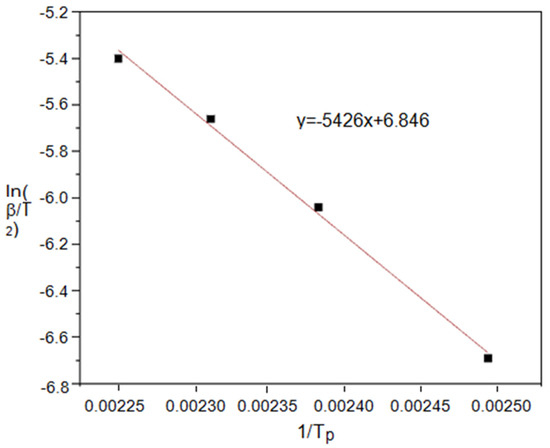
Figure 6.
Linear regression equation between ln(β/T2) and 1/Tp.
The Ozawa method is another method to obtain dynamic parameters whose advantage is that experimental errors caused by different assumptions about the reaction mechanism function can be avoided. It is usually used in checking the activation energy value obtained by other methods. The Ozawa method formula can be expressed as:
We obtained a straight line by plotting ln β—(1⁄Tp) (see Figure 7) and making linear regression. The Ea of 46.15 kJ/mol of the curing reaction can be obtained from the slope of the line.
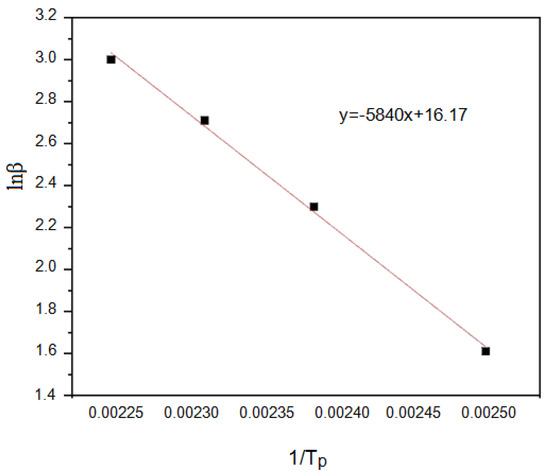
Figure 7.
Linear regression equation between lnβ and 1/Tp.
The reaction activation energy Ea calculated according to the Kissinger method and the Ozawa method was approximately 46 kJ/mol, indicating that the reaction was easy to carry out.
3.3. Study on Flame Retardancy of Epoxy Resin System
LOI and UL-94 tests were carried out to investigate the flame retardancy, and the results are shown in Table 3. From Table 3, it can be seen that different phosphorus content of epoxy resin system could significantly increase the vertical combustion grade and limit oxygen index of the material as the content of phosphorus in the component increases, indicating that the introduction of curing agent DOPO-MAC greatly improved the flame-retardant effect of epoxy resin. When the phosphorus content was 1.0%, the P-1.0 system reached a UL94 V-0 with an LOI of 30.9%.

Table 3.
Flame retardant properties of different resin systems.
When the content of phosphorus was 1.5%, LOI could reach up to 31.8%, which indicated that with the increase of phosphorus content in the epoxy resin system, the flame retardant effect was obviously enhanced. The introduction of flame retardant curing agent named DOPO-MAC played a very important role in the epoxy resin system. The reason could be described as follows: When the resin system was heated and burning, the P-O-C bond of DOPO structure in the system would be broken and rearranged to form phosphoric anhydride or polyphosphoric acid products to dehydrate the polymer and reduce the ambient temperature. At the same time, the thermal decomposition of phosphoric acid could promote the carbonization of the polymer and form a compact carbon layer to isolate heat and oxygen, and prevent the release of combustible gases from the heat burning process of the polymer. The test results showed that the synthesized curing agent DOPO-MAC used in the curing of epoxy resin system could prepare high efficiency and halogen free flame retardant epoxy resin materials.
3.4. Thermal Properties
The thermal stability of the resin system was further studied by thermogravimetric analysis (TGA). As shown in Figure 8, the thermal weight loss curve of samples having phosphorus content from 0% to 1.5% for epoxy resin system was measured in the atmosphere of N2, the initial thermal decomposition temperature (T5%) of four different resin systems was recorded according to the thermal weight loss curve, and the maximum thermal decomposition temperature (Tmax) and the residual mass were recorded as shown in Table 4.
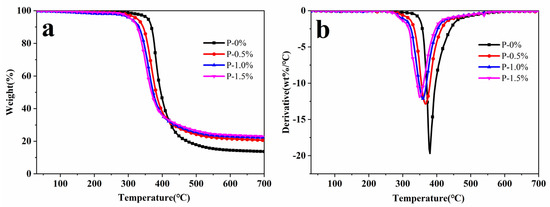
Figure 8.
TGA (a) and DTG (b) curves of different resin systems in N2.

Table 4.
TGA and thermomechanical data.
Where Td, 5% was the temperature when mass loss weight was 5 wt%, Td, max was the temperature when mass loss weight was 50%. Figure 8 and Table 4 show that the thermal decomposition of the resin system has only one weight loss interval in the atmosphere of N2, and with the increase of phosphorus content, the Td, 5% and Td, max of the resin system were reduced to a certain extent. The phosphorus containing groups easily decomposed at a relatively low temperature. Therefore, the introduction of phosphorus-containing structure had an adverse effect on the thermal stability of the solidified substance [28,29]. On the other hand, the P-O-C bond caused the initial decomposition of the polymer system due to thermal cracking in a lower temperature. With the increase of phosphorus, the residual mass increased, indicating that the introduction of DOPO-MAC increased charring ability [30,31].
Phosphorus-containing components decomposed and produced phosphoric acid, which acted as dehydrating agent to promote the dehydration of polymers into chars. The dense carbon layer inhibited the overflow of flammable gas, and isolated oxygen and heat source so as to prevent the polymer thermal oxidation, reduced the oxidation of heat and improved the flame retardant performance [32,33].
Figure 9 presents the tan δ and storage modulus curves, and the relevant data including glass transition temperature (Tg) and crosslinking density (Ve) are collected in Table 4. From Table 4, the Tg of flame retardant epoxy resins showed a growing trend with the increasing of phosphorus content. The Ve of flame retardant epoxy resins declined compared with unmodified epoxy, which was attributed to large steric resistance of DOPO groups. In addition, the storage modulus of flame retardant epoxy resins at 50 °C were bigger than unmodified epoxy, suggested that rigidity of samples was improved. Thus, the improvement in Tg was mainly attributed to the greater rigidity and the limited movement of epoxy chain segments caused by DOPO groups.
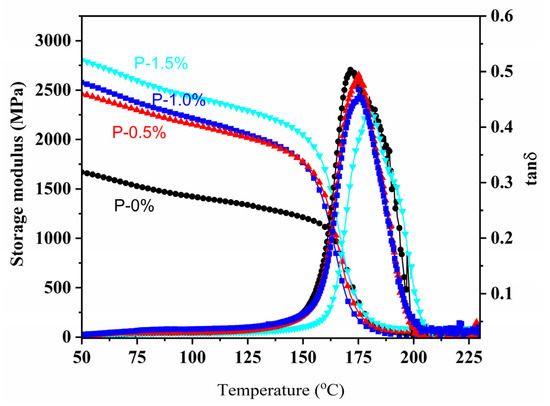
Figure 9.
DMA curves of epoxy resins.
3.5. Mechanical Properties
Figure 10 shows the tensile and flexural properties of all the cured resins. Both the tensile strength and modulus were increased with the addition of DOPO-MAC. P-0% system showed an average tensile strength of 74.3 MPa. For P-0.5%, P-1.0% and P-1.5%, their tensile strength was 75.4, 80.5 and 83.5 MPa, respectively. Their flexural performances presented Figure 10 also illustrated almost the same variation trend as the tensile properties. From P-0% to P-1.0%, a slightly increment in flexural strength was observed, which should be attributed to the compatibility and higher rigidity of systems containing DOPO-MAC.
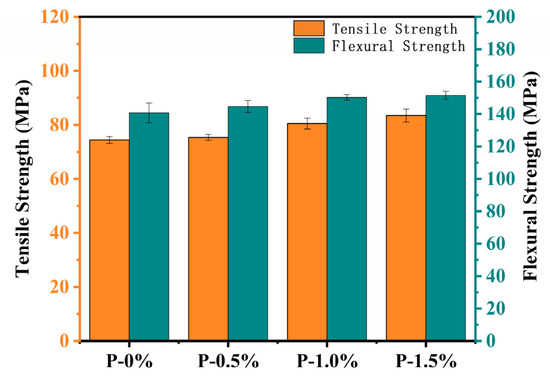
Figure 10.
Tensile and flexural strengths of composites.
4. Conclusions
In this paper, a novel flame retardant curing agent was synthesized, and used to cure and flame retard epoxy resins. The study on curing behavior showed that DOPO-MAC was an effective curing agent for epoxy resin. Additionally, the results of combustion test showed that both vertical combustion grade and the LOI value of the cured product increased with the increase of phosphorus content in the epoxy resin system. The LOI values of DOPO-MAC/epoxy resin were increased by 22.8% for P-0, 28.4% for P-0.5, 30.9% for P-1.0 and 31.8% for P-1.5, and the cured product reached UL 94 V-0 rating when the phosphorus content was 1.0%, which demonstrated the DOPO-MAC could effectively improve the flame retardant properties of epoxy resin materials. In addition, the composite materials had excellent mechanical properties due to their good compatibility and excellent structure.
Author Contributions
Conceptualization, Y.S. and Y.P.; methodology, Y.S.; software, Y.S.; validation, Y.S., Y.P. and Y.Z.; formal analysis, Y.S.; investigation, Y.S.; resources, Y.P.; data curation, Y.S. and Y.P.; writing—original draft preparation, Y.S.; writing—review and editing, Y.S.; visualization, Y.S.; supervision, Y.P.; project administration, Y.S.; funding acquisition, Y.P. All authors have read and agreed to the published version of the manuscript.
Funding
This research received no external funding.
Institutional Review Board Statement
Not applicable.
Informed Consent Statement
Not applicable.
Data Availability Statement
The data presented in this study are available on request from the corresponding author.
Acknowledgments
We would like to acknowledge all support for this work by the Wuhan Institute of Technology. The authors would like to acknowledge the support of Wuhan Institute of Technology for paying the Article Processing Charges (APC) of this publication and for their financial support.
Conflicts of Interest
The authors declare no conflict of interest.
References
- Xiong, Y.; Jiang, Z.; Xie, Y.; Zhang, X.; Xu, W. Development of a DOPO-containing melamine epoxy hardeners and its thermal and flame-retardant properties of cured products. J. Appl. Polym. Sci. 2013, 127, 4352–4358. [Google Scholar] [CrossRef]
- Min, Y.; Li, P.; Yin, X.-G.; Ban, D.-M. Synthesis and characterization of an novel flame retardant based on phosphaphenanthrene for epoxy resin. Polym. Bull. 2017, 74, 1–10. [Google Scholar] [CrossRef]
- Yan, W.; Yu, J.; Zhang, M.; Qin, S.; Wang, T.; Huang, W.; Long, L. Flame-retardant effect of a phenethyl-bridged DOPO derivative and layered double hydroxides for epoxy resin. RSC Adv. 2017, 7, 46236–46245. [Google Scholar] [CrossRef] [Green Version]
- Zhu, Z.; Lin, P.; Wang, H.; Wang, L.; Yu, B.; Yang, F. A facile one-step synthesis of highly efficient melamine salt reactive flame retardant for epoxy resin. J. Mater. Sci. 2020, 55, 12836–12847. [Google Scholar] [CrossRef]
- Xu, Y.-J.; Shi, X.-H.; Lu, J.-H.; Qi, M.; Guo, D.-M.; Chen, L.; Wang, Y.-Z. Novel phosphorus-containing imidazolium as hardener for epoxy resin aiming at controllable latent curing behavior and flame retardancy. Compos. Part B Eng. 2020, 184, 107673. [Google Scholar] [CrossRef]
- Jin, F.-L.; Li, X.; Park, S.-J. Synthesis and application of epoxy resins: A review. J. Ind. Eng. Chem. 2015, 29, 1–11. [Google Scholar] [CrossRef]
- Liu, Q.; Wang, D.; Li, Z.; Li, Z.; Peng, X.; Liu, C.; Zhang, Y.; Zheng, P. Recent Developments in the Flame-Retardant System of Epoxy Resin. Materials 2020, 13, 2145. [Google Scholar] [CrossRef] [PubMed]
- Chen, R.; Luo, Z.; Yu, X.; Tang, H.; Zhou, Y.; Zhou, H. Synthesis of chitosan-based flame retardant and its fire resistance in epoxy resin. Carbohydr. Polym. 2020, 245, 116530. [Google Scholar] [CrossRef]
- Zhu, Z.-M.; Wang, L.-X.; Lin, X.-B.; Dong, L.-P. Synthesis of a novel phosphorus-nitrogen flame retardant and its application in epoxy resin. Polym. Degrad. Stab. 2019, 169, 108981. [Google Scholar] [CrossRef]
- Zhou, X.; Mu, X.; Cai, W.; Wang, J.; Chu, F.; Xu, Z.; Song, L.; Xing, W.; Hu, Y. Design of Hierarchical NiCo-LDH@PZS Hollow Dodecahedron Architecture and Application in High-Performance Epoxy Resin with Excellent Fire Safety. ACS Appl. Mater. Interfaces 2019, 11, 41736–41749. [Google Scholar] [CrossRef]
- Yao, Z.; Qian, L.; Qiu, Y.; Chen, Y.; Xu, B.; Li, J. Flame retardant and toughening behaviors of bio-based DOPO-containing curing agent in epoxy thermoset. Polym. Adv. Technol. 2019, 31, 461–471. [Google Scholar] [CrossRef]
- Wang, H.; Li, S.; Zhu, Z.; Yin, X.; Wang, L.; Weng, Y.; Wang, X. A novel DOPO-based flame retardant containing benzimidazolone structure with high charring ability towards low flammability and smoke epoxy resins. Polym. Degrad. Stab. 2021, 183, 109426. [Google Scholar] [CrossRef]
- Duan, H.; Chen, Y.; Ji, S.; Hu, R.; Ma, H. A novel phosphorus/nitrogen-containing polycarboxylic acid endowing epoxy resin with excellent flame retardance and mechanical properties. Chem. Eng. J. 2019, 375, 121916. [Google Scholar] [CrossRef]
- Tan, Y.; Shao, Z.-B.; Chen, X.-F.; Long, J.-W.; Chen, L.; Wang, Y.-Z. Novel Multifunctional Organic–Inorganic Hybrid Curing Agent with High Flame-Retardant Efficiency for Epoxy Resin. ACS Appl. Mater. Interfaces 2015, 7, 17919–17928. [Google Scholar] [CrossRef] [PubMed]
- Wang, P.; Chen, L.; Xiao, H.; Zhan, T. Nitrogen/sulfur-containing DOPO based oligomer for highly efficient flame-retardant epoxy resin. Polym. Degrad. Stab. 2020, 171, 109023. [Google Scholar] [CrossRef]
- Wang, H.; Zhu, Z.; Yuan, J.; Wang, H.; Wang, Z.; Yang, F.; Zhan, J.; Wang, L. A new recycling strategy for preparing flame retardants from polyphenylene sulfide waste textiles. Compos. Commun. 2021, 27, 100852. [Google Scholar] [CrossRef]
- Salmeia, K.; Gaan, S. An overview of some recent advances in DOPO-derivatives: Chemistry and flame retardant applications. Polym. Degrad. Stab. 2015, 113, 119–134. [Google Scholar] [CrossRef]
- Jian, R.-K.; Ai, Y.-F.; Xia, L.; Zhao, L.-J.; Zhao, H.-B. Single component phosphamide-based intumescent flame retardant with potential reactivity towards low flammability and smoke epoxy resins. J. Hazard. Mater. 2019, 371, 529–539. [Google Scholar] [CrossRef] [PubMed]
- Zhang, Q.; Yang, S.; Wang, J.; Cheng, J.; Zhang, Q.; Ding, G.; Hu, Y.; Huo, S. A DOPO based reactive flame retardant constructed by multiple heteroaromatic groups and its application on epoxy resin: Curing behavior, thermal degradation and flame retardancy. Polym. Degrad. Stab. 2019, 167, 10–20. [Google Scholar] [CrossRef]
- Liang, B.; Cao, J.; Hong, X.; Wang, C. Synthesis and properties of a novel phosphorous-containing flame-retardant hardener for epoxy resin. J. Appl. Polym. Sci. 2013, 128, 2759–2765. [Google Scholar] [CrossRef]
- Wirasaputra, A.; Yao, X.; Zhu, Y.; Liu, S.; Yuan, Y.; Zhao, J.; Fu, Y. Flame-Retarded Epoxy Resins with a Curing Agent of DOPO-Triazine Based Anhydride. Macromol. Mater. Eng. 2016, 301, 982–991. [Google Scholar] [CrossRef]
- Shao, Z.-B.; Zhang, M.-X.; Li, Y.; Han, Y.; Ren, L.; Deng, C. A novel multi-functional polymeric curing agent: Synthesis, characterization, and its epoxy resin with simultaneous excellent flame retardance and transparency. Chem. Eng. J. 2018, 345, 471–482. [Google Scholar] [CrossRef]
- Xu, Y.-J.; Chen, L.; Rao, W.-H.; Qi, M.; Guo, D.-M.; Liao, W.; Wang, Y.-Z. Latent curing epoxy system with excellent thermal stability, flame retardance and dielectric property. Chem. Eng. J. 2018, 347, 223–232. [Google Scholar] [CrossRef]
- Xie, W.; Huang, S.; Tang, D.; Liu, S.; Zhao, J. Synthesis of a furfural-based DOPO-containing co-curing agent for fire-safe epoxy resins. RSC Adv. 2020, 10, 1956–1965. [Google Scholar] [CrossRef] [Green Version]
- Tang, H.; Zhu, Z.; Chen, R.; Wang, J.; Zhou, H. Synthesis of DOPO-based pyrazine derivative and its effect on flame retardancy and thermal stability of epoxy resin. Polym. Adv. Technol. 2019, 30, 2331–2339. [Google Scholar] [CrossRef]
- Wang, H.; Yuan, J.; Zhu, Z.; Yin, X.; Weng, Y.; Wang, Z.; Yang, F.; Zhan, J.; Wang, H.; Wang, L. High performance epoxy resin composites modified with multifunctional thiophene/phosphaphenanthrene-based flame retardant: Excellent flame retardance, strong mechanical property and high transparency. Compos. Part B Eng. 2021, 227, 109392. [Google Scholar] [CrossRef]
- Wen, Y.; Cheng, Z.; Li, W.; Li, Z.; Liao, D.; Hu, X.; Pan, N.; Wang, D.; Hull, T.R. A novel oligomer containing DOPO and ferrocene groups: Synthesis, characterization, and its application in fire retardant epoxy resin. Polym. Degrad. Stab. 2018, 156, 111–124. [Google Scholar] [CrossRef]
- Klinkowski, C.; Lin, Z.; Dring, M. DOPO-Based Flame Retardants: Synthesis and Flame Retardant Efficiency in Polymers. Mater. China 2013, 32, 144–158. [Google Scholar]
- Wang, C.S.; Lin, C.H. Synthesis and properties of phosphorus containing advanced epoxy resins. J. Appl. Polym. Sci. 2000, 75, 429–436. [Google Scholar] [CrossRef]
- Zhang, Y.; Yu, B.; Wang, B.; Liew, K.M.; Song, L.; Wang, C.; Hu, Y. Highly Effective P–P Synergy of a Novel DOPO-Based Flame Retardant for Epoxy Resin. Ind. Eng. Chem. Res. 2017, 56, 1245–1255. [Google Scholar] [CrossRef]
- Yang, S.; Hu, Y.; Zhang, Q. Synthesis of a phosphorus–nitrogen-containing flame retardant and its application in epoxy resin. High Perform. Polym. 2019, 31, 186–196. [Google Scholar] [CrossRef]
- Zhao, W.; Liu, J.; Peng, H.; Liao, J.; Wang, X. Synthesis of a novel PEPA-substituted polyphosphoramide with high char residues and its performance as an intumescent flame retardant for epoxy resins. Polym. Degrad. Stab. 2015, 118, 120–129. [Google Scholar] [CrossRef]
- Yan, W.; Zhang, M.-Q.; Yu, J.; Nie, S.-Q.; Zhang, D.-Q.; Qin, S.-H. Synergistic Flame-retardant Effect of Epoxy Resin Combined with Phenethyl-bridged DOPO Derivative and Graphene Nanosheets. Chin. J. Polym. Sci. 2018, 37, 79–88. [Google Scholar] [CrossRef]
Publisher’s Note: MDPI stays neutral with regard to jurisdictional claims in published maps and institutional affiliations. |
© 2022 by the authors. Licensee MDPI, Basel, Switzerland. This article is an open access article distributed under the terms and conditions of the Creative Commons Attribution (CC BY) license (https://creativecommons.org/licenses/by/4.0/).